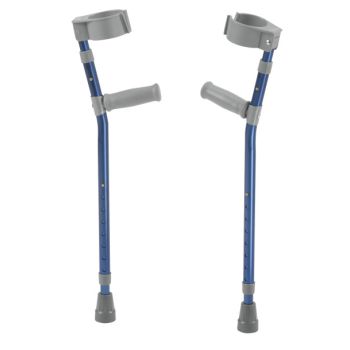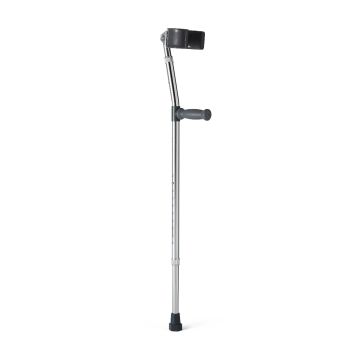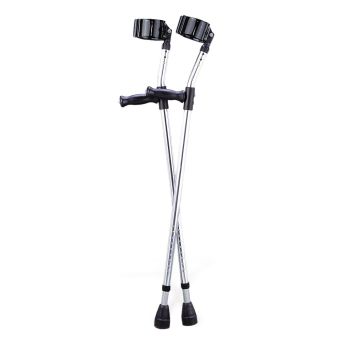Free shipping orders over $50
Best Crutches | Most Comfortable Crutches
Constant debates swirl over which types represent the best crutches on the market. Some people choose to have the best forearm crutches, while other people tend to prefer the ease of use associated with axillary crutches. At AvaCare Medical, we have some of the best crutches, designed by the top manufacturers in America such as Drive Medical, Medline, Guardian, Invacare, and many more! Read More...
-
Bariatric Heavy-Duty Crutches
Starting at $53.83 -
Pediatric Forearm Crutches
Starting at $88.40 -
Standard Aluminum Crutches
Starting at $20.90 -
Medline Forearm Crutches
Starting at $35.55 -
Guardian Forearm Crutches
Starting at $40.48 -
Lightweight Forearm Crutches
Starting at $75.40
What Makes Crutches the Best?
When purchasing crutches, there are two types to consider – axillary crutches (or armpit crutches, also sometimes called standard crutches) and forearm crutches (also known as lofstrand crutches, elbow crutches, or wrist support crutches). Depending on the situation, the user’s preference, and the length of time that the crutches may be needed, different crutches will be best for different users. Good crutches are affordable, and provide exceptional stability and support for the user in partial or non-weight bearing applications.
Armpit Crutches: Best for Short Term Use
Under the arm crutches are the best in terms of providing core balance and stability, but they are not usually meant for long-term use. Therefore, they make some of the best crutches for knee injury use. Many people also consider these the best crutches for knee surgery or when they suffer from broken bones, as they’re intended for short term use. While they are not always considered the most comfortable crutches available on the market, there are many accessories and cushioning options that can be purchased and used to make them much easier to use, as well as more comfortable overall. Axillary crutches are not meant to be used by a person who is non-weight bearing on both legs though, and if used improperly, they can cause armpit nerve damage which can cause problems with the arms and even a person’s hands (such as grip, feeling, or circulation).
Forearm Crutches: Best Crutches for Long Term Use
Often referred to as the best type of crutches and the most comfortable crutches out there, forearm crutches emerged in the 1950s and have made a significant impact on the industry. They are intended for people who have long-term disorders or disabilities, such as cerebral palsy, musculoskeletal disorders (for instance, muscular dystrophy or polio), and many others who can stand with arm support but still require assistance with mobility and support. The best forearm crutches for long term use have a more ergonomic design to aid in comfort, are adjustable, and feature a comfortable forearm grip which helps the user maintain balance. They also have the added advantage that they often help to improve a person’s physical ability.
Unfortunately, even the best elbow crutches don’t necessarily support all the trunk weight of a user. In such circumstances, one may need to use axillary crutches or find another alternative such as a wheelchair. Further, while elbow crutches may be easier for some people to use, they require more upper body and core strength. However, they do help to distribute a user’s weight evenly throughout the arm instead of just putting all of the hands (something that armpit crutches do).
How to Choose the Best Crutches
A person’s choice of crutches will depend on what type they need to buy and how they need to use their crutches. Some people may need a short-term solution that enables them to bear some weight on one or both legs. In these cases, as mentioned above, underarm crutches are the best solution. Moreover, many long-term or completely non-weight bearing needs may be met more easily with forearm crutches. There are additional things that a user needs to consider when looking for the best top-rated crutches on the market as well.
Brand Name
Believe it or not, the brand name of crutches almost always correlates to their quality. Here at AvaCare Medical we only carry the best mobility manufacturing brands. All of our products are manufacturer tested to ascertain that they reach the top tier in quality. Most crutches also come with a manufacturer’s warranty that remains dependable as long as the regulations stated on the manual are met at all times.
Weight Capacity
The weight capacity of a set of crutches is extremely important. Many people don’t realize that when they add on weight; for instance, when they are carrying a backpack full of books, they are increasing the amount of weight the crutches are now carrying. Therefore, if a person’s weight is close to the weight capacity of a standard set of crutches (which is about 250 to 350 pounds for axillary crutches, or 175 to 350 pounds for forearm crutches), and they add enough weight to go over, they may put themselves at risk for serious injury. Further, they may be open to possible damage to the crutches themselves, or even voiding of the manufacturer’s warranty should an event or injury occur.
Height and Adjustability
Being able to adjust the height of crutches is another important factor. Certain crutches come in various sizes to accommodate users of differing heights, and they still often need slight adjustments in order to fulfill the user’s needs and maintain good posture. A lot of people make the mistake of not properly adjusting the height of their crutches, and by doing so, they end up hunching over, which can cause spinal issues, and even increase the risk of losing their balance. A user’s back is supposed to be relatively straight while using crutches, and the bulk of the weight is to be put on the hands or the arms (the latter being the case in forearm crutches). Users are not meant to support their full weight on their shoulders, armpits, or their backs.
How the Crutches Will Be Used
This is another determining factor when choosing the best crutches. Comfort and stability are equally important when making a selection, and the reason why the person needs comforts directly influences the decision for which type to get and how to use them. Some people have been known to use axillary crutches with one hand in certain scenarios, while others require the use of both hands. The same applies to elbow crutches as well.
Find the best crutches for your needs at a reasonable price on AvaCare Medical! All of our crutches come with a satisfaction guarantee, and if you have any questions or would like help with your order, we’re here for you. Dial 1-877-813-7799 to speak with a representative, chat with a care rep live, or simply email us and our well-trained caregiver experts can assist you with your order today!









